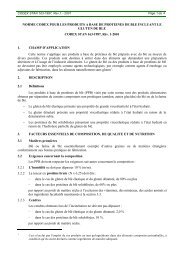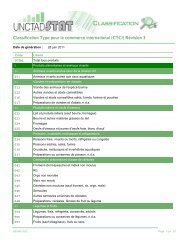The Role of SPS Barriers in Fruit Juice and Fresh Fruit Markets
The Role of SPS Barriers in Fruit Juice and Fresh Fruit Markets
The Role of SPS Barriers in Fruit Juice and Fresh Fruit Markets
Create successful ePaper yourself
Turn your PDF publications into a flip-book with our unique Google optimized e-Paper software.
<strong>The</strong> <strong>Role</strong> <strong>of</strong> <strong>SPS</strong> <strong>Barriers</strong> <strong>in</strong> <strong>Fruit</strong><strong>Juice</strong> <strong>and</strong> <strong>Fresh</strong> <strong>Fruit</strong> <strong>Markets</strong>Suzanne D. ThornsburyPresented to the 7 th InternationalEconomic Outlook Conference for Citrus<strong>and</strong> Non-Citrus <strong>Juice</strong>sOctober 26-27, 2000Orl<strong>and</strong>o, Florida
Sanitary <strong>and</strong> Phytosanitary <strong>Barriers</strong>•Non-tariff restrictions on <strong>in</strong>ternational trade to protectplant, animal or human health <strong>in</strong> the import<strong>in</strong>g country•Widely used, most recognized as justified regulatory<strong>in</strong>tervention•Can be a nontransparent means to limit free-tradeopportunities•Impacts on the economics, the <strong>in</strong>ternational discipl<strong>in</strong>e,<strong>and</strong> the access to fruit juice <strong>and</strong> fresh fruit markets
<strong>The</strong> Economics <strong>of</strong> Intervention•Any market <strong>in</strong>tervention will have distributionaleffects with<strong>in</strong> society•<strong>SPS</strong> barriers may raise net benefits to society <strong>in</strong>clud<strong>in</strong>gbenefits to producers <strong>and</strong> consumers•Once established a <strong>SPS</strong> barrier will (at least partially)<strong>in</strong>sulate the domestic economy from conditions <strong>in</strong>world markets <strong>and</strong> may provide protection aga<strong>in</strong>stexotic pest or disease <strong>of</strong> concern
Implications for Risk•<strong>SPS</strong> barriers provide a tool to <strong>of</strong>fset risk for theimport<strong>in</strong>g country•Probabilities <strong>of</strong> pest <strong>in</strong>festation, establishment, <strong>and</strong>impacts estimated by physical scientists•Economic evaluations <strong>of</strong>ten fail to take these risks<strong>in</strong>to account <strong>and</strong> merely consider trade flows
Implications for Risk•<strong>SPS</strong> barriers <strong>in</strong>troduce additional risks for export<strong>in</strong>gcountries•Uncerta<strong>in</strong>ty over ga<strong>in</strong><strong>in</strong>g <strong>and</strong> ma<strong>in</strong>ta<strong>in</strong><strong>in</strong>g marketaccess <strong>and</strong> trade volume can reduce shipments•Risk is magnified for highly perishable productssuch as fresh fruit
Who pays the cost <strong>of</strong> enforcement?•Depends on policy <strong>in</strong>strument used to implementthe regulation•Depends on the number <strong>of</strong> trad<strong>in</strong>g partnersaffected
<strong>The</strong> <strong>SPS</strong> Agreement•Primary <strong>in</strong>strument for multilateral regulation <strong>of</strong><strong>SPS</strong> barriers•Negotiated dur<strong>in</strong>g the GATT Uruguay Round amongconcerns over the ability <strong>of</strong> countries to circumventdiscipl<strong>in</strong>es <strong>of</strong> the Agreement on Agriculture•Provides guidel<strong>in</strong>es for government behavior•Both substantive <strong>and</strong> procedural discipl<strong>in</strong>es
<strong>The</strong> <strong>SPS</strong> Agreement•Recognition <strong>of</strong> legitimate rights <strong>of</strong> import<strong>in</strong>g countriesto protect national health <strong>and</strong> safety•Encouragement <strong>of</strong> harmonization based on st<strong>and</strong>ardsset by recognized <strong>in</strong>ternational organizations•Scientifically based assessment <strong>of</strong> risk
<strong>The</strong> <strong>SPS</strong> Agreement•Applied only to the extent necessary•Do not unjustifiably discrim<strong>in</strong>ate between Members•Equivalence•Regionalization•Notification
<strong>SPS</strong> Notifications Circulated, 1999WTO MembersMembersMeasures Notified Notify<strong>in</strong>g--- number --- -- percentage---High Income 32 42Upper-Middle Income 25 54Lower-Middle34 38IncomeLow Income 4 10Total 95
<strong>SPS</strong> <strong>Barriers</strong> as Disguised Protection•Political <strong>in</strong>centives rema<strong>in</strong> to <strong>in</strong>tervene <strong>in</strong> fruitjuice <strong>and</strong> fresh fruit markets•Interests <strong>of</strong> producers <strong>and</strong> consumers <strong>of</strong>ten overlapwith concerns such as food safety or resourceconservation•Cost <strong>of</strong> formal action by compet<strong>in</strong>g nations can bevery high
Questionable <strong>SPS</strong> <strong>Barriers</strong> to U.S. Exports,1996 Survey ResultsGeographic RegionProductAfricaAmericasEastAsiaEuropeMiddleEastOceanaTotalNumber <strong>of</strong> <strong>Barriers</strong> <strong>and</strong> Estimated Trade Impact <strong>in</strong> $ MillionCitrus 511.6787.523.014102.0Non-citrusfruits14.02165.023301.4717.052388.3All fruit 34.813.129.0616.9ProcessedFoods10.129.03978.0313.114.7110.0111015.5Total 24.13191.3341370.6313.114.71239.0831522.8
<strong>SPS</strong> <strong>Barriers</strong> <strong>in</strong> <strong>Fruit</strong> <strong>Juice</strong> <strong>and</strong> <strong>Fresh</strong><strong>Fruit</strong> <strong>Markets</strong>- some examples•Grapefruit juice <strong>and</strong> German maximum residue limits•Control <strong>of</strong> fruit fly transmission between Mexico<strong>and</strong> the U.S.•Varietal test<strong>in</strong>g requirements <strong>in</strong> Japan
Prelim<strong>in</strong>ary Positions for the <strong>SPS</strong>Agreement <strong>in</strong> the Next Round•Currently no emerg<strong>in</strong>g consensus (or strongpositions) to reopen the <strong>SPS</strong> Agreement
Issues for the Next Round•How to enforce discipl<strong>in</strong>e <strong>of</strong> the agreements?• What is the role <strong>of</strong> economic cost-benefit analysis<strong>in</strong> sett<strong>in</strong>g st<strong>and</strong>ards?•Where are biotechnology issues governed?•Is a multifunctional def<strong>in</strong>ition <strong>of</strong> agricultureacceptable?•What, if any, concessions will be <strong>of</strong>fered todevelop<strong>in</strong>g or least-developed countries?


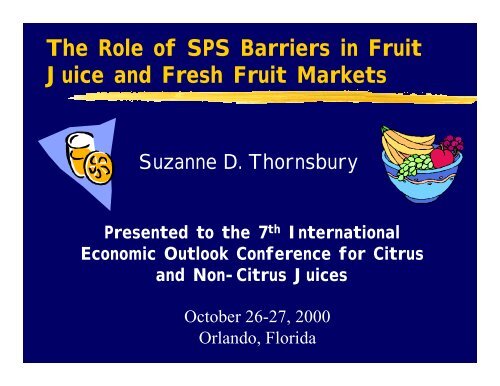
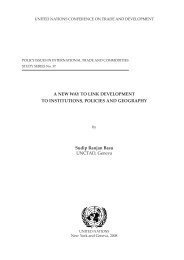
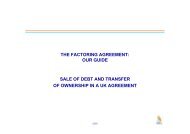

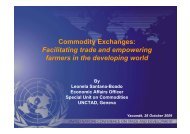
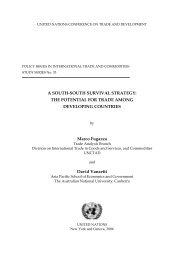
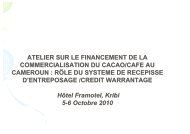
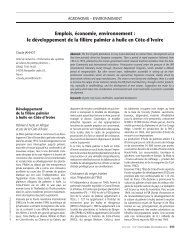
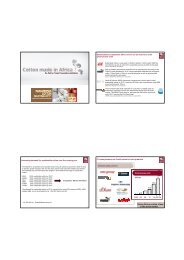
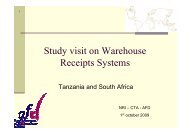
![Warehouse Receipt Systems: Legal Issues [PDF]](https://img.yumpu.com/43979338/1/190x134/warehouse-receipt-systems-legal-issues-pdf.jpg?quality=85)
